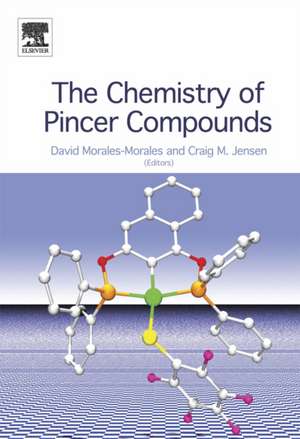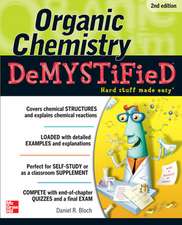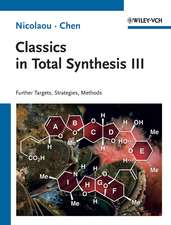The Chemistry of Pincer Compounds
Editat de David Morales-Morales, Craig G.M. Jensenen Limba Engleză Hardback – 12 iun 2007
* Describes the chemistry and applications of this important class of organometallic and coordination compounds* Covers the areas in which pincer complexes have had an impact* Includes information on more recent and interesting pincer compounds not just those that are well-known
Preț: 1084.40 lei
Preț vechi: 1485.48 lei
-27% Nou
Puncte Express: 1627
Preț estimativ în valută:
207.53€ • 215.86$ • 171.32£
207.53€ • 215.86$ • 171.32£
Carte tipărită la comandă
Livrare economică 15-29 aprilie
Preluare comenzi: 021 569.72.76
Specificații
ISBN-13: 9780444531384
ISBN-10: 0444531386
Pagini: 466
Dimensiuni: 165 x 240 x 38 mm
Greutate: 0.98 kg
Editura: ELSEVIER SCIENCE
ISBN-10: 0444531386
Pagini: 466
Dimensiuni: 165 x 240 x 38 mm
Greutate: 0.98 kg
Editura: ELSEVIER SCIENCE
Public țintă
Researchers in metal-mediated organic synthesis, homogeneous catalysis, organometallic chemistry and catalysis. Students studying in the organometallic chemistry field.Cuprins
1. Organometallic Pincer Type Complexes: Recent Applications in Synthesis and Catalysis (J. Dupont et al.).
2. Synthesis and Transformation of Allyl- and Allenyl-Metal Species by Pincer-Complex Catalysis(K.J. Szabo).
3. Chiral Pincer Complexes and their Application to Asymmetric Synthesis (C.J. Richards, J.S. Fossey).
4. Desulfurization Catalyzed by Nickel PCP-Pincer Compounds (J. Torres-Nieto, J.J. Garcia).
5. Pincer Systems as Models for the Activation of Strong Bonds: Scope and Mechanism (B. Rybtchinski, David Milstein).
6. 'Pincer'-Carbene Complexes (E. Peris, R.H. Crabtree).
7. Pincer Complexes Derived from Benzimidazolin-2-ylidene Ligands (F. Ekkehardt Hahn, M.C. Jahnke).
8. Pincer Complexes of N-Heterocyclic Carbenes. Potential Uses as Pharmaceuticals (M.J. Panzner et al.).
9. The Chemistry of PCP-Pincer Phosphinite Transition Metal Complexes (D. Morales-Morales).
10. Nitrogen-Based Pincers: a Versatile Platform for Organometallic Chemistry (P. Chase, G. van Koten).
11. S-P-S and S-C-S Pincer Ligands in Coordination Chemistry and Catalysis (N. Mázailles, P. Le Floch).
12. Pincer Ligand Complexes with Unusual Atoms and Molecular Backbones (H.A. Mayera et al.).
13. Rigid PNP Pincer Ligands and their Transition Metal Complexes (O.V. Ozerov).
14. Pincer, Chelate and Spirocyclic Metal Carbene Complexes from Bis(iminophosphorane)methane Ligands
(R.G. Cavell).
15. Pincer and Chelate Carbodiphosphorane Complexes of Noble Metals (R.G. Cavell).
16. Hypervalent Organotin, Aluminum, Antimony and Bismuth Y,C,Y-Chelate Complexes (R. Jambor, P. Libor Dostal).
17. Stability of Supported Pincer Complexes-Based Catalysts in Heck Catalysis (W.J. Sommer, M. Weck).
18. Dendrimers Incorporating Metallopincer Functionalities: Synthesis and Applications (P. Chase, G. van Koten).
19. Future Trends and Perspectives in the Chemistry of Pincer Complexes (W.D. Jones).
2. Synthesis and Transformation of Allyl- and Allenyl-Metal Species by Pincer-Complex Catalysis(K.J. Szabo).
3. Chiral Pincer Complexes and their Application to Asymmetric Synthesis (C.J. Richards, J.S. Fossey).
4. Desulfurization Catalyzed by Nickel PCP-Pincer Compounds (J. Torres-Nieto, J.J. Garcia).
5. Pincer Systems as Models for the Activation of Strong Bonds: Scope and Mechanism (B. Rybtchinski, David Milstein).
6. 'Pincer'-Carbene Complexes (E. Peris, R.H. Crabtree).
7. Pincer Complexes Derived from Benzimidazolin-2-ylidene Ligands (F. Ekkehardt Hahn, M.C. Jahnke).
8. Pincer Complexes of N-Heterocyclic Carbenes. Potential Uses as Pharmaceuticals (M.J. Panzner et al.).
9. The Chemistry of PCP-Pincer Phosphinite Transition Metal Complexes (D. Morales-Morales).
10. Nitrogen-Based Pincers: a Versatile Platform for Organometallic Chemistry (P. Chase, G. van Koten).
11. S-P-S and S-C-S Pincer Ligands in Coordination Chemistry and Catalysis (N. Mázailles, P. Le Floch).
12. Pincer Ligand Complexes with Unusual Atoms and Molecular Backbones (H.A. Mayera et al.).
13. Rigid PNP Pincer Ligands and their Transition Metal Complexes (O.V. Ozerov).
14. Pincer, Chelate and Spirocyclic Metal Carbene Complexes from Bis(iminophosphorane)methane Ligands
(R.G. Cavell).
15. Pincer and Chelate Carbodiphosphorane Complexes of Noble Metals (R.G. Cavell).
16. Hypervalent Organotin, Aluminum, Antimony and Bismuth Y,C,Y-Chelate Complexes (R. Jambor, P. Libor Dostal).
17. Stability of Supported Pincer Complexes-Based Catalysts in Heck Catalysis (W.J. Sommer, M. Weck).
18. Dendrimers Incorporating Metallopincer Functionalities: Synthesis and Applications (P. Chase, G. van Koten).
19. Future Trends and Perspectives in the Chemistry of Pincer Complexes (W.D. Jones).








